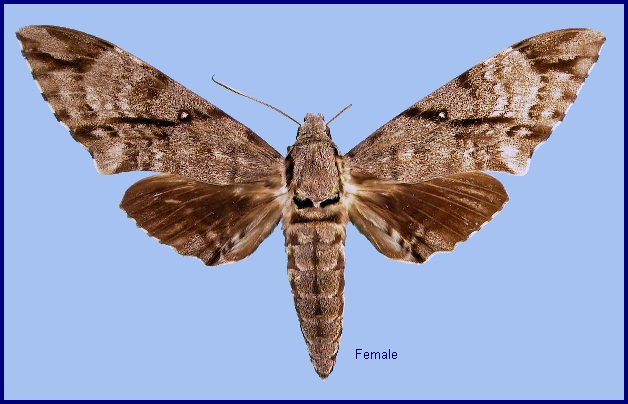
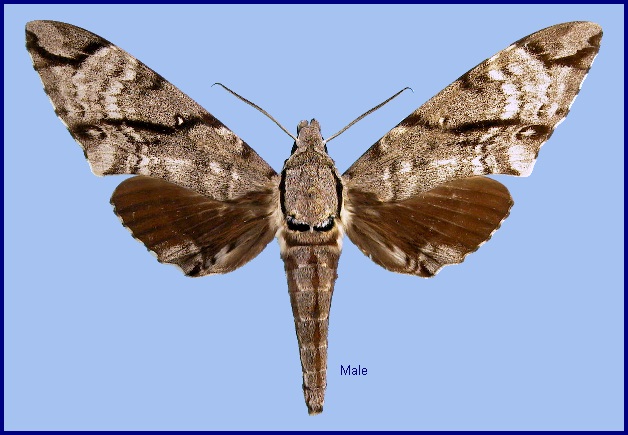
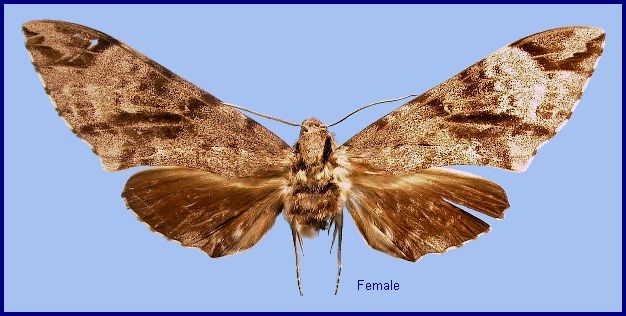
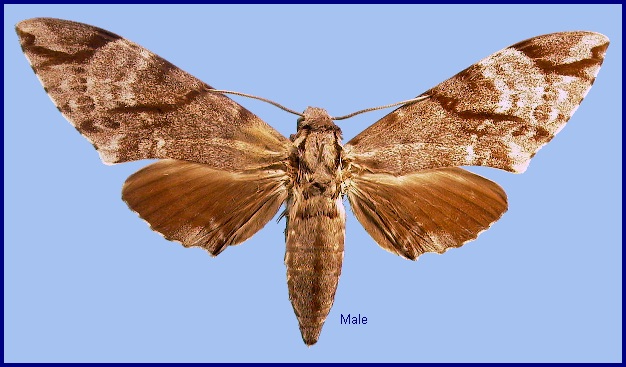
Sphinx analis Felder, R., [1874], in Felder, Felder & Rogenhofer, Reise öst. Fregatte Novara (Zool.) 2 (Abt. 2) : pl. 78, fig. 4. Type locality: [China,] Shanghai.
Synonym. Sphinx analis Felder, R., [1874].
Synonym. Diludia grandis Butler, 1875.
Synonym. Diludia tranquillaris Butler, 1876.
Synonym. Meganoton analis Rothschild & Jordan, 1903.
Synonym. Meganoton analis subalba Mell, 1922.
Synonym. Meganoton analis gressitti Clark, 1937, Proc. New Engl. zool. Club 16: 27. Type locality: Formosa [Taiwan, Nantou Hsien], Hori [Puli].
Note. The small, dark, high altitude, Notonagemia scribae-like population from southeast China (Guangdong, Nanling National Forest Park, 1100m) requires further study with regard to its exact relationship to Notonagemia analis. Although several of these are almost identical to typical Notonagemia scribae from Korea and Japan, DNA barcodes place them firmly within Notonagemia analis.
Note. As there is no significant and consistent genotypic, phenotypic, ecological or biological difference between Notonagemia analis analis and the Taiwanese Notonagemia analis gressitti, the latter has become a synonym of the former.
Wingspan: 106--150mm. Outer margin of forewing not undulate as in Meganoton nyctiphanes and Cerberonoton rubescens, but shallowly sinuate anterior to hind angle. Palpus with second segment smaller than in Meganoton nyctiphanes and Cerberonoton rubescens. Hindtarsus first segment with second row of spines extending close to the base, as in Psilogramma. Eigth abdominal tergite without stridulatory scales on the inner surface.
In the male genitalia, uncus divided into two long and slender processes that are regularly curved ventrad and gradually narrowed to a point; the processes becoming closer a little beyond their midlength. Gnathos produced into a long cylindrical process, slightly bent downward at the apex, which is obtuse. Valve sole-shaped, the dorsal margin bent inwards; a large clay-coloured patch of large, multidentate, ribbed, modified scales present; subdorsal longitudinal groove sharply defined, deep, the fold below it with long bristles. Harpe ladle-shaped, minutely dentate. Phallus with one pointed process that is broad at its base. In the female genitalia, ostial plate only lightly sclerotised, the entire post-ostial part membranous and scaled; the ante-ostial part also membranous; a narrow sclerotised stripe extends to each side from the ostial cavity; the upper edges of these plates continuous, forming an arcuate ridge that borders the ostial cavity posteriorly; the proximal edge of the cavity formed by a very thin membranous fold, which is preceded by a stronger fold.
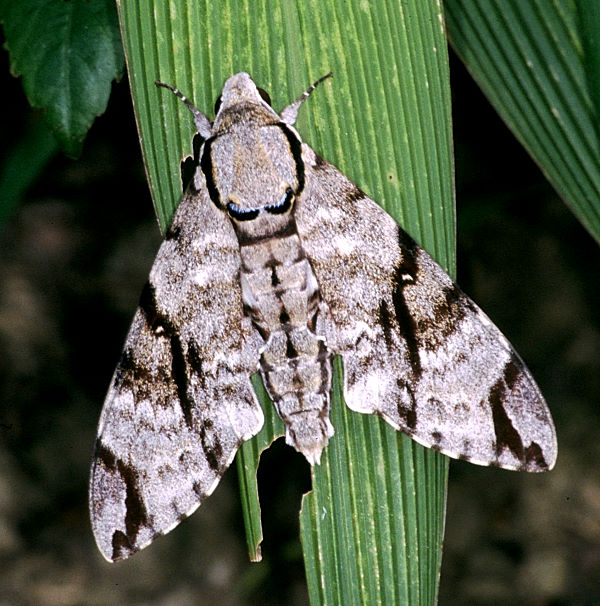
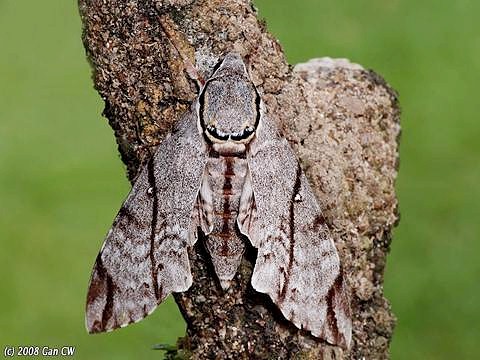
Rarely found below 500m altitude. The resting position of the moth is the same as that of Meganoton nyctiphanes (Bell & Scott, 1937).
China: v (Zhejiang); vi (Guangxi; Zhejiang); 20-27.vi (Yunnan); 2-17.vii (Xizang/Tibet); 25-30.vii (Yunnan); viii (Fujian; Zhejiang). Taiwan: iv (Nantou Hsien); iv-v (Kaohsiung Hsien).
OVUM: Pale yellow, oval (1.25 x 1.50mm), shiny and smooth. Small for the size of moth.
LARVA: Full-fed 82--90mm, horn 11-13 mm. Dimorphic: yellowish-green or greyish-green.
According to Bell & Scott (1937), in the final instar body tapering slightly from segment 6 forward to the large round head; horn long, straight, conical. True clypeus less than half the height of the head. Surface of head and body dull; the segments well defined, with five secondary rings on segments 2 and 3, six on 4, and eight on 5 to 11. Each ring on 2 to 10 has a transverse row of small rounded tubercles, which become smaller on the posterior segments and disappear on 11 and 12. Horn and faces of anal claspers tuberculate, with a triangle of polished, button-like tubercles on the anal flap.
In colour, head and body green/yellow-green above the spiracles, greyish-green/yellow-green below these and on the venter; segments 2 to 4 immaculate. There are faint yellow oblique lateral stripes on segments 5 to 7 and a very pronounced one on 11, the latter running across 12 to base of horn; the dorsal area between the stripes lilac in some individuals. Horn dark above, yellow on the sides. Spiracles oval, greyish-yellow, with the central slit coffee-coloured, the whole lying on oval yellow patch.
A description of a late stage larva from Taiwan is given by Dvořák (2016).

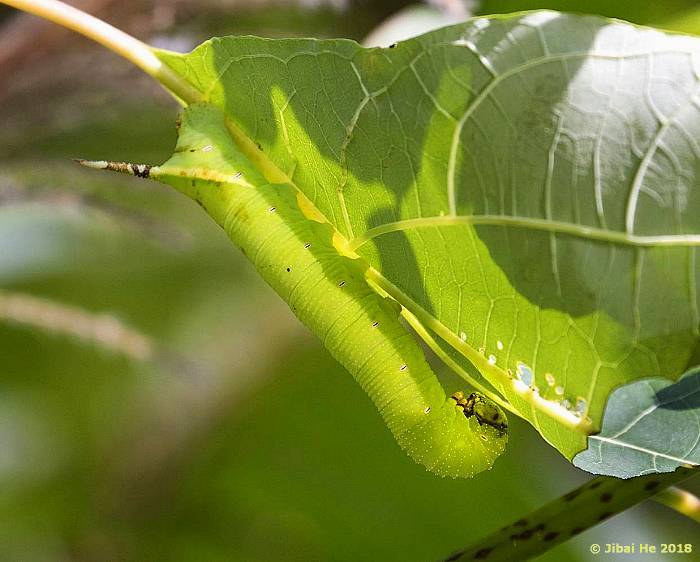
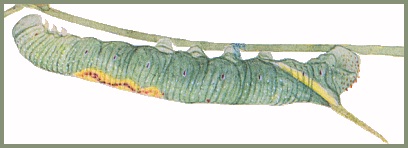
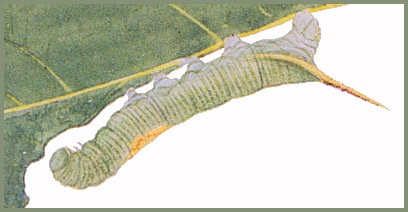
PUPA: 47--60mm. Reddish-brown. Similar in shape to that of Meganoton nyctiphanes; tongue-case free, not curved into a spiral, touching venter at about middle of thorax; the bulbous end reaches to tip of wing-case. Antenna reaching to middle of wing-case; the fore leg shorter and the mid-leg longer than the antenna; coxal piece very small and narrow. Surface shiny, abdominal segments well defined; the sculpturing on segment 4 narrow flat surfaces, broadening slightly laterad; antespiracular ridges on 9 to 11 in the form of three parallel ridges on each. Cremaster stout, conical, rugose above and below, with a ventral median ridge at extremity which is prolonged into a short, highly polished, bifid shaft. Pupation in a cell underground (Bell & Scott, 1937).
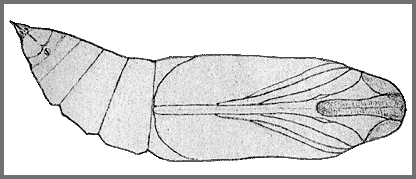
Larval hostplants. Sassafras tzuma in China. Also an occasional pest of Magnolia in that country (Cheng & Huang, 1990). In Taiwan, recorded from Magnolia denudata, Magnolia compressa [syn. Michelia compressa], Michelia alba and Sassafras randaiense. Recorded from Magnolia by Dvořák (2016).
China: Anhui (Mt. Huang Shan; Dayinghong); Shanghai; Zhejiang (Tianmu Shan; Kuocang Mountain Nature Reserve; Chayuan Village); Hubei (Lichuan); Sichuan (Pengshui); Yunnan (Mengla County, Mt. Leigongyan, 2000m; Gaoligong Shan; Songzishanding, 2500m; Deqing/Dêqên); south Xizang/Tibet (Mutu, Namjagbarwa region, 850m (Wang, 1988); Xiachayu, Zayu County); Guizhou (Xinzhaidashan, Zhijin County, 1000-2000m); Hunan (Daweishan); Jiangxi (Mt. Meiling, Nanchang); Fujian (Guangze, 1200m; Longqi Shan); Guangdong (Shaoguan, 700m; ?Nanling National Forest Park, 1100m); Guangxi (Maoer Shan, 1800m; Nanning); Hainan.
Taiwan: Hualien Hsien (Taroko National Park); Nantou Hsien (Puli; Jenai; Renluen, 1400m); Kaohsiung Hsien (nr. Tuona, 12km SE of Shanping, 750m; Shanping, 640m); Taipei Hsien (Fushan; New Taipei City; Wulai); Yilan Hsien (Fushan Botanical Garden, 700m).
Northern India, Nepal, Bhutan (Norbu et al., 2022), southern China, Taiwan, northern Burma/Myanmar (Banmauk, Sagaing Province), northern Thailand and south to central Vietnam (Le & Vu, 2024).
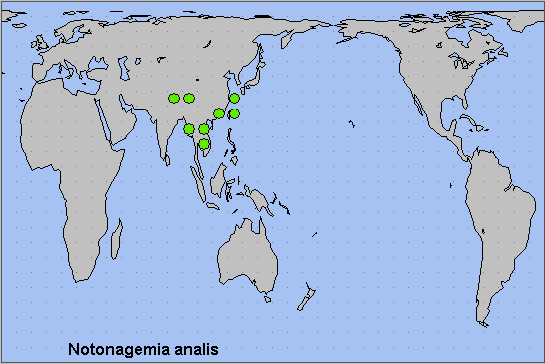
 Return to Sphingidae of the Eastern Palaearctic species list
Return to Sphingidae of the Eastern Palaearctic species list